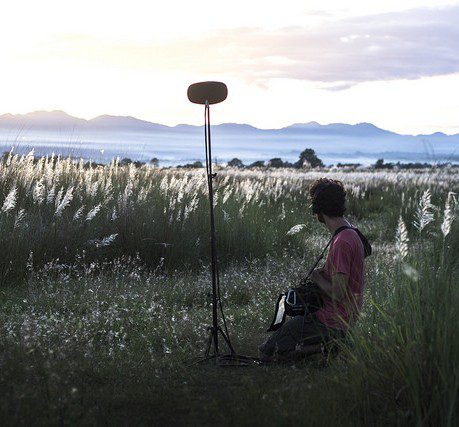A couple of months ago, I left for Nepal for a month of sound recording for Himalayas to Ocean (H2O). The project documents the human story of change, resilience and adaptation in one of the regions most heavily impacted by climate change in the world: the Gandaki River Basin, Nepal.

The team consisted of three graduates of the Oxford University School of Geography (Alice Chautard, Yolanda Clatworthy, Justin Falcone) who worked on the research, photography and writing, a videographer (Ross Harrison) and myself on sound.
In one month, we visited four different regions along the Gandaki River, meeting locals and trying to get to the heart of their experience of change.
I was recording interviews and collecting atmos sound with a streamlined (ish!) location recording kit – see full list below.
For interviews, I used radio-packs for my DPA mics and so that I could attach them to the interviewee and then sit far back to monitor. This meant that once they’d eased into the interview they didn’t have me staring at them and waving a boom pole around their head. For the more ad-hock interviews I’d quickly attach another DPA d:heavyduty to a tent pole and sort of boom with that! Not perfect but it worked, was a lot less invasive than a shotgun-mic in a big windshield and most importantly was very light-weight.
For atmos, I used a variety of mics, including a DPA d:mention 5100, lent to me by the company for the expedition.
One of my favourite things about this part of the trip was the incredibly strong wind that developed every day. Although it made getting around hard, it made everything around us sing! It was perfect – in the morning I could capture nice delicate sounds and in the afternoon, with the help of contact mics and strong Bubblebee Industries windshields, the sound of anything I could find going crazy in the wind.
The trip was incredible, and we collected some great material which is now being put together for distributors. Head to www.himalayastoocean.com to keep updated.
Full Kit List.
I had a great range of kit to this trip, thanks to sponsorship from DPA Mics and Bubblebee Industries.
Sound recorder – Zoom F-8
At first I was a bit reluctant to buy it as I wasn’t sure I trusted it’s pre-amps but I went ahead and bought it as it was the only recorder that had enough inputs in the price range I was looking at. I wanted something that would allow me to experiment with various surround formats. I ended up not needing all the inputs but I was very pleasantly surprised by this product. The pre-amps are pretty clean, it’s very easy to navigate, has most of the features you would find on the more expensive recorders and I ended up using the Bluetooth feature quire a lot. I didn’t bring a mixer to save on weight and managed to do everything I needed on the Zoom F-8 although sometimes the gain knobs felt a bit too and levels where hard to read. The headphone amp was also hard to trust and I had to do a few tests before we left to learn what it was doing to the sound.
2x DPA d:heavyduty 5060
I used these for just about everything! They were great lav-mics but I also used them for recording ambiences, sound effects and put them in all sorts of silly places. As I described earlier, they spent a lot of time dangling of the back of my backpack as a stereo pair on a tent pole (inspired by a Wild Eye nature recording weekend I went to with Chris Watson and Jez Riley French ) and I would also use the tent pole to sort of boom them closer to the sound source when recording trickier sounds. Needless to say they had quite a rough ride but worked 100% throughout the whole trip from flood plains up to the dryness of lower-mustang! I would definitely recommend these for anyone planning a similar trip as I felt I could take risks I would not have taken with other microphones and of course they also sound great (clean with great detail).
DPA d:mention 5100
For a while I had been planning to explore immersive sound recording in the field and in the lead up to the trip I tried a few arrays (I would recommend reading Michael Williams’ work on stereo and multi-channel recording). However, they all involved carrying a lot of extra bits and bobs around. As I was doing my research I was offered the opportunity to try out the DPA d:mention and very quickly realised this had been exactly what I was looking for! It’s very well to spend hours in the studio fine tuning your multi-channel array but when you’re out in the field you want everything to be as hassle free as possible. This mic was just perfect and I can’t say that enough. I was able to stand on suspension bridges or in the middle of an active landslide recording in 5.1. Packed away easily in my backpack, within a minute I could be recording 6 channels of audio. Here again I was able to push what I would have normally thought to be possible whilst recording high quality audio! I tried adding a few more channels using what I had to try and capture some height information but I live in hope that my next expedition involves a 9.1 recording buddy!
BubbleBee Industries Windbubbles
I used these as windshields for my DPA d:heavyduty and they worked very well. I was able to record in quite windy environments without too much trouble and would definitely recommend these to anyone working outdoors. However I would recommend bringing a hard container to store these in – I ruined a couple by accident in my backpack…!
BubbleBee Industries lav-tape, invisible lav-covers and fur pieces
I brought plenty of these and used them pretty much every day! It was easy to prep the lav-mics and hide them on our interviewees. As I mentioned earlier, one of my big worries was invading the private space of people who aren’t used to having so much kit waved around their face. This set up was so simple that I could do it quickly and efficiently then forget about it and monitor out of everyone’s way.
Rode NTG-1
I brought this as a backup and barely used it. I had positioned on a stand for each interview in case anything went wrong but I was lucky and nothing did!
Bubblebee Industries – Spacer Bubble
I had this for the NTG-1 although I didn’t use the mic much the couple of times I did in windy conditions the Spacer Bubble did its job well. A lot less cumbersome than a big windshield it saved be a lot space only in exchange for a slight loss in high frequency content – a small price I was more than willing to pay!
2x Manfrotto light stands
I always bring at least one of these for any outdoor recording. They’re so light and pack down so easily compared to normal mic stands. I used one for the DPA d:mention and could leave it confidently standing in quite windy conditions as the legs stretch out pretty far giving it a good balance. I probably could have done with just the one… the second one just free-rode across Nepal.
2x JrF contact mics
These are just great! Jez Riley French makes them himself and I carry them around everywhere for studio or field recording. These mics are great for capturing unusual sounds and experimenting a bit. My favourite was attaching these to suspension bridges swinging in the wind!
1x JrF hydrophone
Same as the contact mics, this mic was excellent for your unusual sound and discover what’s happening underwater. I had a lot fun trying various things out with this!
Sennheiser G3 radio packs
I used these everyday and they work very well and were reliable throughout the trip. I was surprised by how efficient they were with energy consumption and I’m glad I didn’t get any interferences (despite checking which frequencies I was allowed to use, I’m always worried I’ve missed something when working in a new country… )
2x Swit batteries – S-8073N Li-ion
They were great and never had any power problems. Kept on going for a few days on each!
I had a few other bits and bobs but these were the main components of my set-up. I spent a long time thinking about it and as you can probably tell I was very pleased with it. I won’t change much for the next trip.





